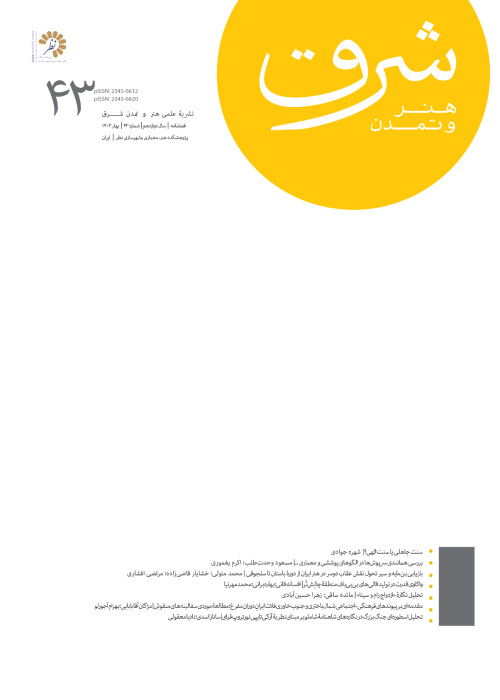Investigating the Similarities of the Head Covers in the Patterns of the Covering and Architecture (A Report on the Resemblance between Eight Patterns of Human Head Covers with Architectural Head Covers in Topkapi Palace)
Author(s):
Article Type:
Research/Original Article (دارای رتبه معتبر)
Abstract:
To understand the origin of artistic roles and arrangements, it is essential, in addition to knowing the main tendencies of the human mind, to study the process of form exchange between related arts. This will help to reveal common morphological features and enable logical analysis. It seems that understanding the relationship between the art of head covers, which is used in two different areas and scales of covering and architecture, is no exception to this rule. By comparing the main lines of the surviving works of these two arts, this article seeks to answer the following questions: To what extent are the architectural head covers similar to those used by individuals in a given historical period? What are the similarities between the head covers used during the Ottoman period (16th-19th centuries) and the architectural covers and elements of the Topkapi Palace in Istanbul? The purpose of this research is to show the similarities in forms between the head covers worn during a particular historical period and the architectural covers used in the Topkapi Palace. The aim is to address any confusion regarding the forms of these objects and to show how the practical experiences and aesthetic achievements, influenced by the semi-collective unconscious, are transferred from one art form to another. The research is descriptive-analytical. It draws upon a psychodynamic approach using the library method. The head cover samples were selected from the Ottoman cultural sphere between the 16th and 19th centuries, and the architectural samples were selected from the Topkapi Palace in Istanbul. Based on the research, it has been found that the head cover patterns of the people living in this region during the Ottoman period have at least eight similar patterns with the head covers of decorative components and architectural elements. It seems that habituation to familiar patterns through their presence in the semi-collective unconscious formed the basis for the development of visual preferences and aesthetic biases.
Keywords:
Language:
Persian
Published:
Journal of Art and Civilization of the Orient, Volume:12 Issue: 43, 2024
Pages:
6 to 17
magiran.com/p2701519
دانلود و مطالعه متن این مقاله با یکی از روشهای زیر امکان پذیر است:
اشتراک شخصی
با عضویت و پرداخت آنلاین حق اشتراک یکساله به مبلغ 1,390,000ريال میتوانید 70 عنوان مطلب دانلود کنید!
اشتراک سازمانی
به کتابخانه دانشگاه یا محل کار خود پیشنهاد کنید تا اشتراک سازمانی این پایگاه را برای دسترسی نامحدود همه کاربران به متن مطالب تهیه نمایند!
توجه!
- حق عضویت دریافتی صرف حمایت از نشریات عضو و نگهداری، تکمیل و توسعه مگیران میشود.
- پرداخت حق اشتراک و دانلود مقالات اجازه بازنشر آن در سایر رسانههای چاپی و دیجیتال را به کاربر نمیدهد.
In order to view content subscription is required
Personal subscription
Subscribe magiran.com for 70 € euros via PayPal and download 70 articles during a year.
Organization subscription
Please contact us to subscribe your university or library for unlimited access!



